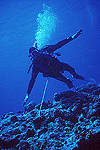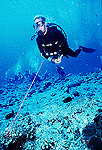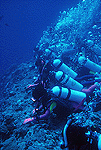
PHOTO TIPS FOR DIVING PALAU
TAKING PICTURES IN A CURRENT
Now you see it, now you don't!!Text and Photos by Kevin Davidson
 Anyone
who's investigated before deciding on a trip to Palau has
probably heard the stories of how strong the currents can
be, "It almost
took my mask off! " or " It was making my regulator purge
by itself! " Although the current can be that strong at times,
in a one week trip to Palau chances are you may experience
that kind of current maybe once, if at all. These kind of
currents happen only
at certain times of the month and for brief periods of time.
Let's also remember that when you actually feel these strong
currents is when you are hanging on to the reef and watching the fish
action.
We will address the hanging on to the reef topic later.
Anyone
who's investigated before deciding on a trip to Palau has
probably heard the stories of how strong the currents can
be, "It almost
took my mask off! " or " It was making my regulator purge
by itself! " Although the current can be that strong at times,
in a one week trip to Palau chances are you may experience
that kind of current maybe once, if at all. These kind of
currents happen only
at certain times of the month and for brief periods of time.
Let's also remember that when you actually feel these strong
currents is when you are hanging on to the reef and watching the fish
action.
We will address the hanging on to the reef topic later.
Throughout the day the tides and currents are doing their usual thing, going high or going low, and in palau there are generally four tidal exchanges in a day and diving plans are made around these tides. Other islands in this area of the Pacific have only one high and one low tide in a twenty four hour period. In as much as we all would prefer to dive with no current, it is believed that the reason palau has so much diversity in marine life is because of the exceptional amount of tidal exchange. When the current is stronger the fish life is more abundant and active. Something else to remember about Palau is that at half moon, reef areas that form a corner will have stronger currents, a good time to get shark photos at Blue Corner. At full or new moon the channels will have the stronger currents, the perfect time to go for a ride through the classic Ulong Channel.
Being a working photographer / diveguide in palau for the past two years the one statement that I tell people frequently is expect the unexpected. Some people act like this is a cop out but what they haven't seen is tides that are sometimes up to an hour early or late or not at all. A dive you would expect to have poor visibility maybe crystal clear or vise-versa or you expect a strong current and it's not. Fear not photographers...there are plenty of dives that are very placid and still have wonderful photo opportunities. Following is what I hope to be good advice to the photographer visiting palau.
1. During a day of diving the boats travel out to the dive sites which is approximately a thirty to forty minute boat ride. Store your gear with some sort of padding under it...don't leave gear on the hard deck of the boat. Vibration can occur and when you jump in at the dive site a critical screw might have come loose and the chance of something going over the wall is possible. Check connections and screws before entering the water. Generally a moderate current carries you down the reef and can actually be quite fun until you want to stop and take a picture. Of course then starts the struggle to get there. As you gaze down to check your equipment you look up and that beautiful scene is gone, now you see it, now you don't!
2. Look ahead of you always and get close to your subject well before you get there. Always be aware of your buoyancy. You are about to interact with the reef, home to countless types of marine life big and small. You want to leave the area the way you found it. Preserving the reef for others to enjoy and saving nature should be important to all of us.
3. As you approach your subject use a light touch and with one or two fingers hang on to something hard or sturdy. It is not difficult to use your good judgement to find something to stable yourself with. Bare rocks and low profile objects that are not brittle is what you are looking for. Don't wear gloves and you will be much more careful and keep your fins up. It's not hard to practice good buoyancy technics. The better you are at this and the more you are aware of what your body is doing underwater, the better the photographer you will be.
 The
Hook
The
Hook
4. A nice little invention used by divers in Palau is "the hook". It is nothing more than a large fishing hook with the tip ground off and a long piece of nylon line secured to your BCD. As you approach the area where you want to stop for a bit, take your hook and place it on a bare low profile piece of rock...somewhere secure and safe. Inflate your vest a little and you'll stay in one place safely without using your hands to clamor around the reef. You will not have to touch or sit on anything.
In
addition, your hands are free to operate photo equipment. Non-photographers
use it to relax more during the dive, save air, and comfortably check
guages. Of course paying attention to where your fins are and always
keeping in mind low impact and no stress to the reef should just be
habit.
 There
are those who belive that the reef hook should not be used and pictures
should be taken without any underwater aids as you pass by the reef.
I can tell you is that on a day when the current is fairly strong
you will fly by the reef and your dive will only last about five minutes.
You will be out in the blue water before you know it. When you are
a diver traveling long distances to this beautiful dive location you
want to maximize your dive time and get the most out of each dive.
So why not use somthing that is far safer on the reef. Remember that
the reef hook is for those times when the current is up and the fish
action is active in a certain area. It is not used on every dive.
Most of the currents in Palau are very manageable when it comes to
getting photos as long as you know what you are getting in to ahead
of time. Some may like it some may not, but the hook does keep you
from ravaging coral.
There
are those who belive that the reef hook should not be used and pictures
should be taken without any underwater aids as you pass by the reef.
I can tell you is that on a day when the current is fairly strong
you will fly by the reef and your dive will only last about five minutes.
You will be out in the blue water before you know it. When you are
a diver traveling long distances to this beautiful dive location you
want to maximize your dive time and get the most out of each dive.
So why not use somthing that is far safer on the reef. Remember that
the reef hook is for those times when the current is up and the fish
action is active in a certain area. It is not used on every dive.
Most of the currents in Palau are very manageable when it comes to
getting photos as long as you know what you are getting in to ahead
of time. Some may like it some may not, but the hook does keep you
from ravaging coral.
5. Do a dive without your camera once and make sure that you feel comfortable in the water. The better your bouancy skills are the better your photos will be...they will be a reflection of your diving skills. Without your camera practice approaching subjects underwater and see if you can control bouancy around the reef. Even when approaching skittish reef fish this skill is invaluable to capture those fish portraits. You can have the best camera system in the world but you wont get the shot if you scare away the subjects.
6. No matter what type of camera system you own, whether it be a camera and housing system or an underwater disposable type, be familiar with what your camera can and cannot do. Every time you change a lens you change the cameras purpose. Get to know the coverage of your strobe or strobes. You don't have to turn it into exact degrees or measurments, just have a good feel for your camera system. As you look at the shots you have taken, learn from them. I know you are saying "I only do it once a year!" if you are at a dive location that has photo services, take advantage of the local photo pro. Spend a little extra for some photo tune up courses if the photo pro is good, its worth the extra time and money. I know if you come visit me in Palau you wont be sorry we met!